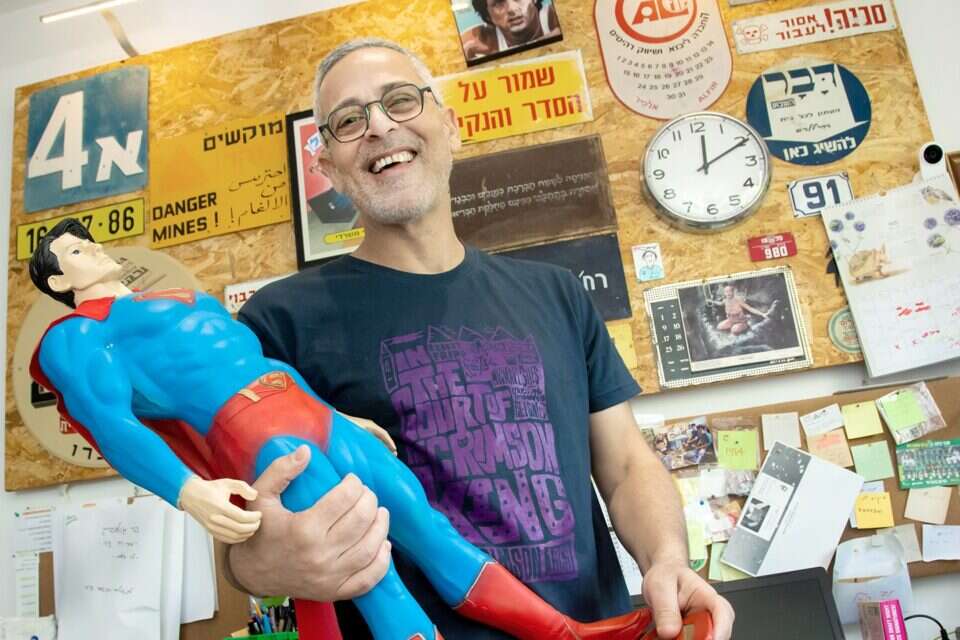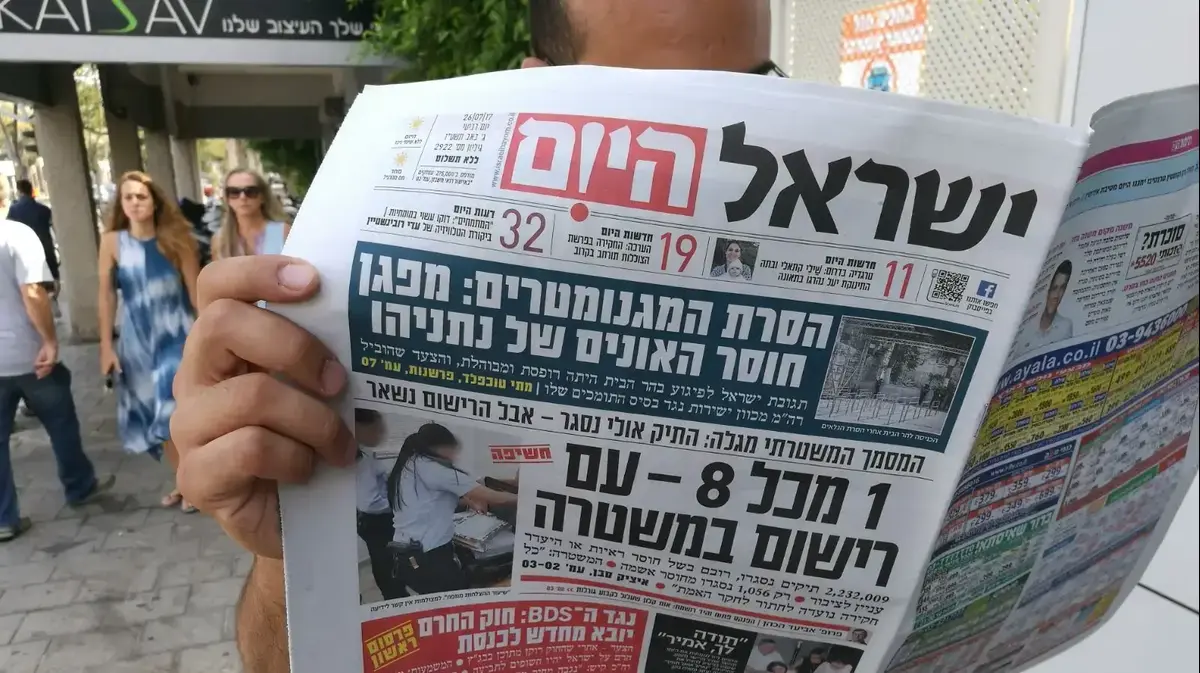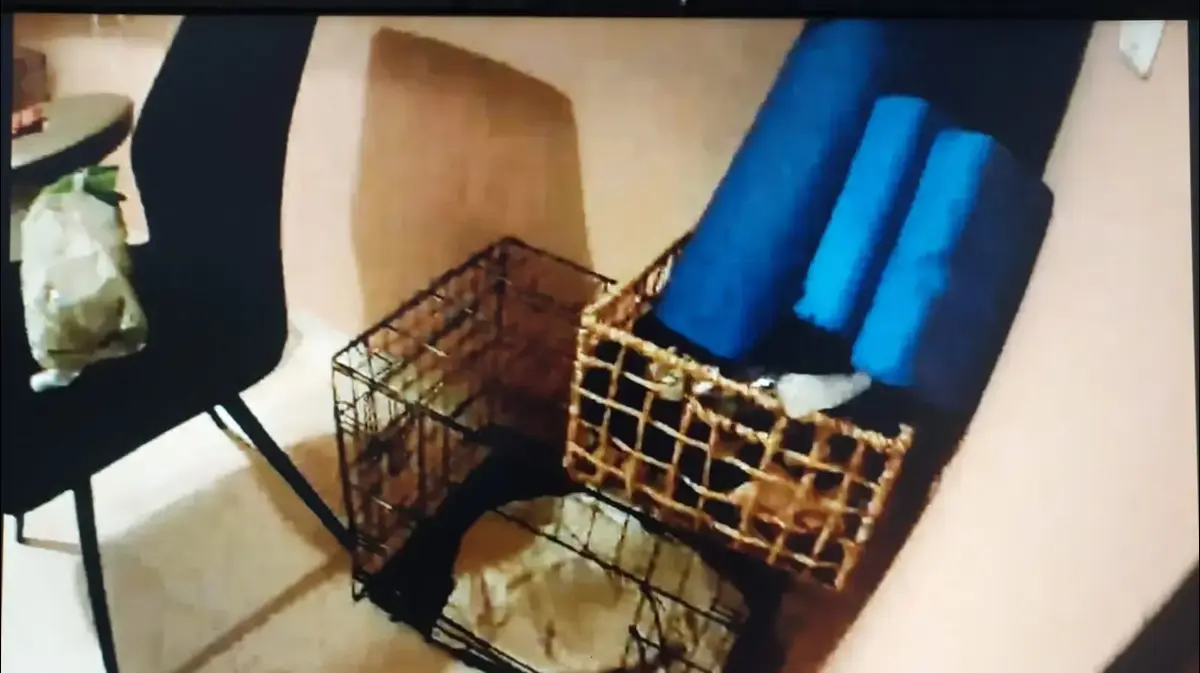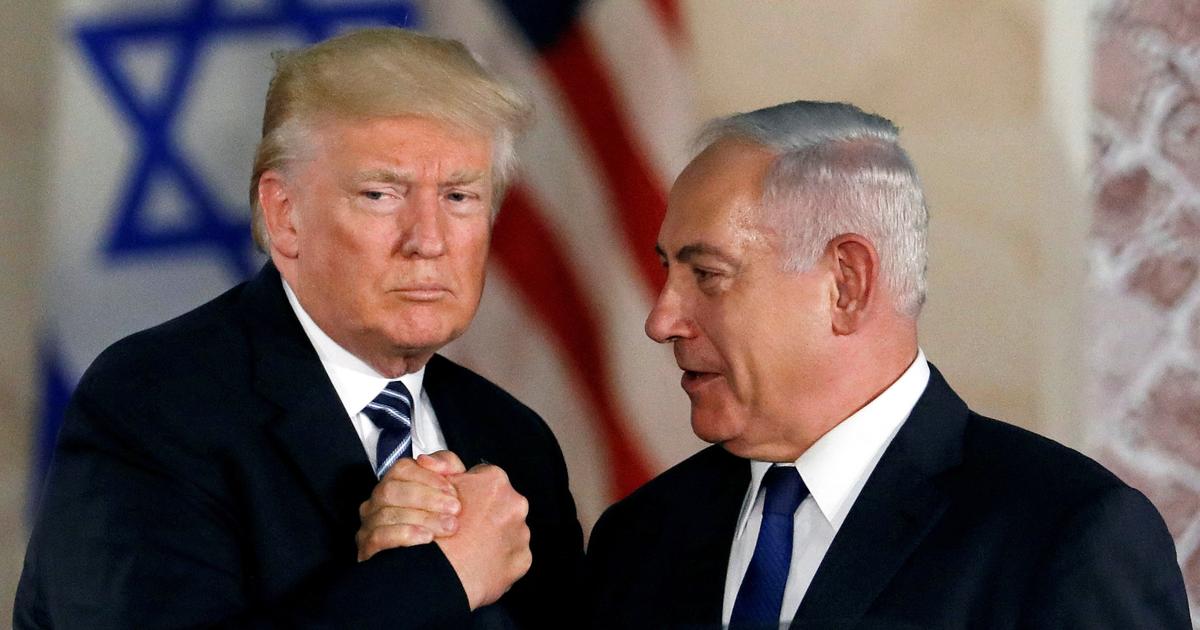The collection - jaw dropped
Mordi Alon finishes making coffee, sits down in his office in Binyamina and begins with his motto: "The key to working here is my knowledge and the lack of knowledge of others. Understand that every human being, starting at the age of about 40, is an unwitting collector and possessor of assets. Sometimes he treats them with contempt, and they may be worth a lot of money. I can tell you that you currently have $10,000 at home, and you didn't know. And I'm not talking about gold, but about objects that are thrown away. You'll say, 'Enough, well.' That's exactly what I'm living for. I serve these people."
I have known Mordi for many years. In the past he was a journalist, and later he was one of the owners of the Glory publishing house, which together with his partner Amir Doron published the successful series of books "Out of Context" - but the publishing house faltered and disappeared, and with it he too disappeared from the spotlight.
In recent years, I have come across Alon more than once online, with the auction house he opened, "Third Time", and with a website that initially specialized in sports collectibles, but over time touched on everything related to our environment: from the history of the country to the "garbage gang" cards. Everything, it turns out, has value.
"The auction house was established five and a half years ago," he says. "Until then, there were three or four in Israel. Each worked in a different field, such as art, banknotes and coins. The chain changed the industry, especially when the Bidspirit auction portal opened, which said that whoever wanted to be an auction house would get a platform. With the click of a button, you will set up a catalog and sell. Today there are almost 400 auction houses in Israel."
How do you get from writing to auctions?
"Our publishing house shut down, and I got bomba at the level of bankruptcy. Trauma. I worked for an international company as a content consultant, but something inside felt empty. And when the sales arena came in, I helped someone. One of my friends asked, 'Why don't you do it yourself?' When you go bankrupt, the last thing you want is another business with risk, but I started anyway, with a lot of trepidation. I soon discovered that I woke up in the morning with a smile and went to bed with a smile. Every day is a history lesson. The doll arrives, which is now behind you, so you research it and learn something new every day."
Alon was born 52 years ago in the Mahane David neighborhood in southern Haifa, which over the years changed its name to Neve David. "I grew up in a home where there was nothing, barely food," he says. "It's a neighborhood that was a transit camp, absorbing North African immigrants in the '50s. While all the children were picking up the card album on duty, I looked with wide eyes and realized that if I wanted a collection, I needed patience. So after everyone finished the album and threw it away, I chased the cards as far as the wind took them. A Superman album? I had eight, because no one wanted them. Piles of collectibles."
Much of this vast collection was wiped out in a fire that broke out in his mother's house, but the trauma did not prevent Alon from continuing to collect. The realization that it was possible to profit from the occupation came when former soccer referee Abraham Klein invited him to be the ghostwriter for his autobiography.
Klein, considered the most senior Israeli football referee, refereed memorable matches at the World Cup, including the quarter-final between Brazil and Italy at the 1982 World Cup. "In one of his anecdotes, he talked about the match he judged between Brazil and England at the '70 World Cup, and how he took the ball and whistled to the end. I said, 'It's a pity you didn't protect him.' And he replied: 'I actually saved, does that interest you?' I said, 'Are you serious? It's worth a fortune.'
"He took me to see the collection, and my jaw dropped. There were thousands of items there, from 1959 to the mid-80s. He recognized that no museum would display the collection. He said that these things didn't speak to his children, and that at least someone else would enjoy them. For six months I catalogued the items and put them up for sale on eBay – and it was crazy. On the first day we sold for about $15,<>, and then an email came from FIFA, the World Football Association: 'Stop the sale, the items interest us. We want to come to Israel.' And so it was.
"Beyond the fact that Abraham Klein received an eternal display at the FIFA Museum in Zurich with 69 items he collected, I suddenly realized how much power collectibles have."
Are there collectors of sports memorabilia in Israel?
"One day a merchant I work with called me and said he was in the Ramle-Lod market, where people spread their wares on the ground. He said: 'I'm filming something for you and sending.' It was two football shirts. I was shocked. I asked how much he was asking for, and he said, '50 shekels is okay?' I said: 'I'm not a maniac, I'll pay you 700 shekels for a shirt.' He galloped to me so I wouldn't regret it. Two goalkeeper shirts, one blue and one black, of Yossi Mizrahi, who was Beitar Jerusalem's goalkeeper. They were on the floor, filthy. The next day I went up to Jerusalem after we washed them, and I met a customer who paid 4,500 shekels each."
What is the "holy grail" of sports collectors in Israel?
"Maybe the official match form of the 1977 European Basketball Cup final - Maccabi Tel Aviv vs. Varese - that I also know who owns it. In general, everything related to the historic soccer match between Israel and the Soviet Union from 1956, which can reach thousands of dollars. And of course – every item from the Mexico '70 World Cup, the only time Israel participated in the tournament. I offered almost 40,<> shekels for one of the national team's players' jerseys, and he still politely refused."
I tell him it's really an industry, so Mordi laughs, goes to one of the closets for a moment and comes back with a Brazil national team shirt wrapped in plastic. "I'll show you what an industry is," he suggests. "Former players who are no longer playing, and sponsors are not lining up to hug
They - there are companies that buy their time. For example, Pele is invited, and for two hours he signs as many shirts as possible, and they are documented, including attaching a certificate of authenticity. So I have a shirt with Pele's signature, and Maradona's signature, and when Maradona died, the value jumped insanely. A Maradona shirt can reach as much as 20,<> shekels. I was smart enough to buy a few more at every opportunity, but you also ask yourself every morning where is the limit? Because it comes at the expense of other things."
Mordi's office is packed with objects, and each has a fascinating story. On the wall hangs a painting by the late actress Mona Silberstein, created by the painter Yoram Lukov, who at the time was close to the legendary Lol gang. "One day they evacuated one of the largest printing houses in the country," Mordi says. "A friend called and said, 'Come.' Until we got to Tel Aviv, everything was cleaned there, and then we saw a homeless man coming out of the back street. We asked him, 'What's in there?' and he said, 'Nothing.' There was a shelter cluttered with disqualified works, piles of posters. Among other things, I found works by Yoram Lukov.
That's part of the point - you don't understand what you're finding while strolling down the street. Two months ago, someone posted on Haifa residents' Facebook page: 'The family of the painter Gershon Knispel threw everything into the street.' My son lives in Talpiot Market. I called him at 12 o'clock at night and said, 'Go.' Rain, flood, everything got wet. Crazy assets. But in the end he found an illustrated personal diary, which Knispel had written and drawn up when he boarded the Merchant Navy ship in 1981 and sailed to Europe. An item I estimate is worth thousands of dollars.
"When I drive on the roads of Binyamina, a community established 100 years ago, I drive at 15 kilometers per hour and constantly look sideways. Once I found a pile of 'garbage bunch' cards. The most expensive card of the Israeli garbage bunch we sold - $2,200. Hammer price, no fees."
I ask Mordi who the buyers are. "Collectibles are not for those who don't make ends meet," he clarifies. "One is to show that I have a lot of money and that I can buy a Mickey Mantle card for $10 million, and these are also people who believe in opportunities. Yesterday, I opened a box of NBA cards from the 2017-18 season that sold for $30 at the time. There are certain cards you want to get, so there was a Jayson Tatum card from the Boston Celtics, which for him was worth everything. On the order of $ 300-400. It's a stock exchange.
"Until two months ago, Ja Morant's card was considered the most wanted because they said he was the next thing in basketball, and then a picture came out of him with a gun in a strip club and $50,2019 on the floor, and he was suspended. There are graphs for each card, and its began to go down and down. Now you can buy Morant for pennies. So you can say, 'I'm buying, because one day he'll go through therapy and be the biggest and the card will be worth tens of thousands of dollars' – or eat it. Today there is talk of Erling Haaland from Manchester City, but we have been on him since <>, even then we started collecting his stickers. It's all gambling."
Items from the collection of Mordi Alon,
Chen, Mordi's son, entered the room. He was released a few months ago and is now working with his father. Chen is in charge of overseas sales - it turns out that some of the realities in Israel are also interested in the substantial. "Anything related to Pele, even if it is written in Hebrew, has been hijacked," Alon says. "I uploaded the poster for the movie 'The Wizard of Oz' in Hebrew. I have 3,500 cinema, information, and entertainment posters in my collection. Someone bought it for $200 and wrote: 'Thank you, this is the last poster that completed my magician collection in all languages.'
"There was a poster for a Kung Fu movie in Hebrew, one of the movies that used to be shown at the Central Bus Station, and Jackie Chan himself bought it. I wrote to him: 'Are you the real Jackie?' and he replied: 'I acted in the movie and never saw the poster.'
You can sit with Mordi all day and hear stories from him about the girl who let him vacate her grandparents' apartment, which hasn't been opened since 1969, or about one who heard a lecture by him and asked if he would be interested in letters Herzl wrote, and about the boy from the Golan Heights who brought a shoebox full of "garbage gang" cards he found with his aunt and raked in 51,<> shekels in the sale.
I ask him if there's an item he won't give up. "On May 26, 1984, Maccabi Haifa won the first championship in its history," he says. "Everyone broke into the grass at the end of the game, and I didn't. The gallery was empty, and I went row after row collecting game tickets, flags, scarves. So I went down to the grass and took what I could. I didn't say at the time, 'I'm a 13-year-old rebel, a collector.' It was necessary to keep memory and history.
"Basically, everything about that championship season is my best memory, by far from anything else I've ever had. From everything related to that day I have a huge collection. I won't sell it, and I'll die with it. Everything else is a matter of price."
Beitar's hat and brown uniform
Not far away, still in Binyamina, is the "Ancient House - Art" gallery, run by Moti Harari and his sister Esther. I've known Moti since school, a good friend from class. A few weeks ago, his father, Arie z"l, passed away, and already at shiva you could see the items that the family has held for generations.
"At shiva, I put on my father's Beitar hat, the beret he used to serve in the Nahal, and my grandfather's Beitar hat with the brown uniform. When they said about Beitar that its brown uniform resembled those of the fascists, it changed to blue," he says. "I also put on the hat of my grandfather's father, who was an officer in World War I in Franz Joseph's army, in the Austro-Hungarian Empire. I told myself that maybe I was exaggerating the connection to history and that someone would missee conservation. I can understand that, but it's my connection to those people."
Moti (56) is a graduate of the Sorbonne University in Paris in art history and archaeology, and a graduate of the Technion in curatorship. Today, among other things, he renovates antique furniture and is an expert appreciator of art objects. Apparently something in the gardens passed from his grandfather, Shlomo, who owned antique shops in Vienna. In the early 30s, he closed them, immigrated to Israel and opened a store at 81 Allenby Street in Tel Aviv, becoming the city's first antiquities dealer.
"It was an antique shop and a home decoration. At Tel Aviv fairs, my grandfather always set up a stand," Moti says. "The beautiful story is that my grandfather put coins in the shop window and wrote next to each coin where it came from. One day someone came into the store and asked, 'How do you know that what you wrote is true?' and then my grandfather, who was a merchant, said: 'What do you mean? Prof. Sukenik told me.' Prof. Eliezer Sukenik was Yigal Yadin's father and a well-known archaeologist, and it turns out that the person who asked was Prof. Sukenik himself. They became friends.
"I remember that every year, on Herzl's memorial day, the showcase was dedicated to the contract of the state – from business cards, to a drawing by Hermann Struck with Herzl's signature, to caricatures. On Holocaust Remembrance Day, he would once again dedicate the showcase to the subject. My grandfather had good hands."
Photo: Moshe Shai,
Moti holds a small binder containing rare items from the family collection. A manuscript by composer Johann Sebastian Bach, a business card by Alfred Dreyfus, letterhead of the Jewish Legion, letterhead of philanthropist Moshe Montefiore, including his signature, and an invitation leaflet to the large demonstration against the reparations agreement with the German government.
"When the subject of reparations came up, my grandfather put in the shop window the uniform of an Auschwitz prisoner and a large bag, which he tied like a bag of money, and wrote: 'Today we will know the price of every Jew.' It was his protest," Moti says. "By the way, there was a store in Paris called Chevari, which closed its doors a few years ago, and you could buy anything you wanted: a letter from Louis Pasteur or Louis XVI, a Dreyfus business card, and people bought. I think it was closed because of the finger."
What do you mean?
"Today a person knows that he can see these things while browsing Google, and doesn't feel the need to hold them physically. Like in Corona you could have a virtual tour of the Louvre Museum without being in Paris. It won't stay, people will want the real thing. If a student wants to read newspapers of yesteryear, he sees issues online from the day the state was proclaimed. But I sign you that in 15 years he will want to touch the newspapers, and then it will take on a different dimension."
Moti says he underwent the "brainwashing" at home – a positive wash, he says. They would tell him "tales" – from Bar Kochba to the underground movements to Israel's wars – and put it in his head how important it is to preserve history. "We have newspapers that my grandfather collected from the Holocaust period, with headlines like 'Auschwitz liberated,' 'Paris occupied,'" he says. "My father continued. Every important event that appeared in the newspaper, he put aside the issue. Not because of the commercial value, but to hold the history. They felt like they were living important moments, and that's how I feel too.
"As a child I kept the newspaper signing the peace treaty with Egypt, and since then all the election campaigns, wars and operations. I kept stickers like 'The people with the Golan,' 'Hello, friend,' and 'Netanyahu is good for the Jews.' To all the teachers at the local school, I offered the newspaper collection, so that the students would hold a piece of history from the underground, from the War of Independence, from the Night of the Bridges. I have all the newspapers, and I thought it was a good didactic medium. Tell you that every year they take away from me? Absolutely not."
Items from the collection of Mordi Alon,
Moti travels around Israel quite a bit, visiting people who want to appreciate what remains after the death of their loved ones. "You get the contents of an apartment or attic that they haven't seen in 50 years, and where they put things that are 80 or 100 years old. There are those who have power and search the Internet, and there are people who don't know how to do it and call me.
"Unfortunately, I also entered this juncture with the passing of my father. Many times you don't know whether to throw away or save. At age 70, will I have the energy to read old letters? Some people say, 'Clean a table, I don't care about anything,' and some people say that one day, when they get tired of the screen, they'll come back. I often tell people: 'Don't touch this, you'll be sorry if you sell the candlesticks or the menorah.' I don't want to
take that away from them."
Why shouldn't they sell?
"Because of the sentiment. There is a fashion world today that goes through everything quickly, there is no need to delay. Saw the menorah, took pictures - and that's enough for him. I know it's something that will pass."
Do you define yourself as a "collector"?
"I have something about my genes. Here, I have a sign from the Giro d'Italia international cycling race that took place in Israel in 2018. When the race was over, I immediately ripped off and took it. I felt it was history, a first race that probably won't come back, and I know the sign will have value. Why? Because there are a lot of cyclists here. So I said maybe a bicycle workshop would hang at her entrance, or some freak would want a souvenir.
"When I repair furniture, I can take off a flower decoration or take a piano wheel, because there are no copper wheels today. I keep because I know that one day these things will serve me, to the point of preserving old veneers. I can show you the package of veneers I collected. It is not hoarding in the sense of interference, but in the sense that it can always be used. Today you see thrift stores opening on every corner. It's another facet of collecting. People want modern furniture, but one that won't cut down another tree for it and won't harm
nature for it."
Items from the collection of Mordi Alon,
With Moti, the things that are passed down from generation to generation are not for sale, and there are items that he is more connected to than others. "I won't sell them. We have a consensus in the family that the collection is not sold, but owned, because it is a piece of history. I connect mainly with items related to Beitar and Etzel, because I grew up in the Revisionist movement. When I hold Betar leaflets, or lesson plans from an instructor who needs to convey the full weight of history to the campers, I connect to it. In these things, from the past, there is an ideology."
Binyamina-Givat Ada Regional Council
Binyamina-Givat Ada is a local council in the Haifa District. Founded in 2003 from the Union of Binyamina and Givat Ada Local Councils.
Neighbourhoods: Binyamina, Givat Ada, Givat Hapoel, Carmei Binyamina, Givat Chen
Area: 25.7 sq km
Population: 15,627 (2019)
* Data according to the Central Bureau of Statistics website
Wrong? We'll fix it! If you find a mistake in the article, please share with us









